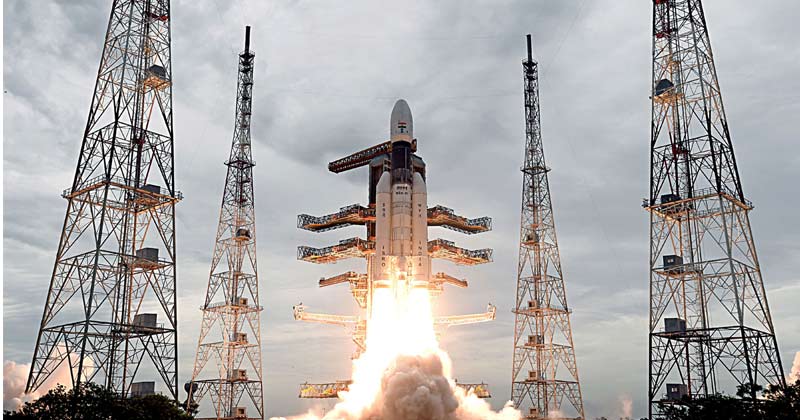India is well on its way to becoming the fourth nation in the world to land gently on the moon. But the Chandrayaan 2 will take 13 times longer than the Apollo 11.
In 1984, an Indian citizen Rakesh Sharma flew into space for the first time through the missile of the former Soviet Union. Today, India is well on its way to landing on the Moon as the fourth nation in the world. Almost simultaneously with the historical date of the first manned moon landing of the Americans 50 years ago, on Monday, lifted India’s strongest-propelled rocket to the prestigious flight. While the Apollo astronauts reached the moon in four days, the Indian unmanned mission takes over 50 days because of a complex trajectory.(Image credit: Indian Space Research Organisation)
It will not be known until the beginning of September whether the gentle landing on the Earth’s satellite will succeed. Afterward, a small Indian rover will drive around the Moon’s surface near the South Pole, where no robot or astronaut has ever been seen before.
The historic mission Chandrayaan 2 of the Indian Space Agency ISRO started in 2011 as an Indo-Russian project. After the breakdowns in the Russian space flight, India decided to continue the project alone. India’s Prime Minister Narendra Modi cleared that India wants to play in the top league of space nations and has several ambitious projects, including manned missions.
With a cost of about 146 million dollars, the project is considered relatively cheap again proving its not the money but the brain that put the man on the moon.
In any case, India wants to make a name for itself as a low-wage space nation. A week ago, the launch of the rocket was canceled just 56 minutes before take-off. Now, however, the start went according to plan. The rocket lifted off at 14:43 local time from the Satish Dhawan Space Centre in the southern Indian state of Andhra Pradesh without complications. If the mission is to succeed, India would be the fourth country after Russia, the US and China to gently land a lunar surface.
A lot of jealousy and criticism is seen amongst other nations like the nations in the European Union and other cash-rich nations that are deemed as ‘Developed Nations’ and have been trying to accomplish the same objective (to put man or machine on the moon) but are unable to do so. Here is a lot of hatred the Europeans and other nations have shown by indirectly condemning the Indian will and attempts of going to space by saying that India is wasting money and should focus upon removing poverty. Israel is a friend of India but Israel wanted to snatch that title away from the Indians, but their attempt failed in April with a crash of their landing capsule. The Indian moon mission is many times more complex compared to Israel’s attempt, and similar to the landing of the Chinese at the back of the moon in January.
In total, the Indians now have sent three units towards the Moon with their 43-meter-high GSLV Mk-III rocket. On the one hand, there is the lunar orbiting satellite (Chandrayaan 2), equipped with a special camera and instruments for detecting water ice – and for a lifespan of one year. On the other hand, there is the unmanned lander Vikram and a small, 27-pound Rover Pragyan with six wheels. The lander and the rover, however, are only designed for the life of a single lunar day, or about 14 earth days. The rover has a top speed of one centimeter per second and can move up to 500 meters from the landing point.
The arrival of the Indian landing system takes so long compared to the Apollo mission because the payload of the rocket initially will orbit the earth for three weeks before the engines are fired on the 23rd day to set course for the Moon. The orbit around the moon is also initially very elliptical and it will again spend six days in the moon’s orbit before attempting the landing.
The Chandrayaan 2 is equipped with GSLV Mark III rockets which are not the most powerful rocket but does the job well. The Apollo missions had Saturn V rockets that were the most powerful rockets ever built by mankind hence they did not require orbiting the earth for days and days to obtain the required speed. The Apollo mission was to carry astronauts to the moon and back, Chandrayaan 2, on the other hand, is only carrying a payload for research and moon landing. The GSLV Mark III seems like a suitable thruster to do the job as it saves fuel as well.
India also plans a manned lunar landing mission
For India, it is the second moon mission, but the first moon landing attempt. India launched the Chandrayaan-1 space probe in 2008 that was supposed to orbit the moon for two years. But the mission ended in August 2009 after systems failed onboard the $ 80 million satellite.
The current project is only one component of a long-term plan of ISRO in space. By 2022 at the latest, that is 75 years after Indian independence from the British colonial power, “a son or daughter of India is flying in space with the Indian flag in hand,” announced Prime Minister Narendra Modi last year.


